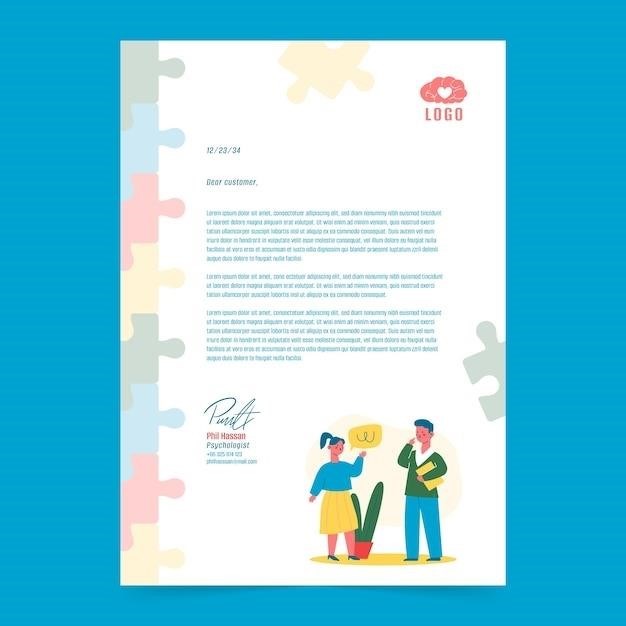Relationship Agreement PDF⁚ A Comprehensive Guide
A relationship agreement, also known as a cohabitation agreement or a relationship contract, is a legally binding document that outlines the terms and conditions of a relationship between two people. This agreement can cover a wide range of topics, such as financial responsibilities, property ownership, and decision-making. It serves as a roadmap for the couple, ensuring clarity and mutual understanding in their journey together.
What is a Relationship Agreement?
A Relationship Agreement, often referred to as a cohabitation agreement or relationship contract, is a legally binding document that outlines the terms and conditions of a relationship between two individuals. It serves as a roadmap for the couple, establishing clear expectations, responsibilities, and boundaries. Unlike a traditional prenuptial agreement, which is typically signed before marriage, a relationship agreement is designed for couples who are not legally married but choose to live together or have a committed relationship. These agreements are becoming increasingly popular as couples seek to define their relationship dynamics, particularly in cases where traditional marriage isn’t a priority.
The purpose of a relationship agreement is to provide a framework for a successful and harmonious partnership. It encourages open and honest communication about essential aspects of the relationship, minimizing misunderstandings and potential conflicts. This document can address a variety of issues, including financial contributions, property ownership, decision-making processes, and responsibilities within the household.
In essence, a relationship agreement acts as a written contract that outlines the couple’s mutual understanding and commitment to their relationship. It serves as a reference point for navigating challenges, making important decisions, and ensuring fairness and equity within the partnership.
Why Create a Relationship Agreement?
Creating a relationship agreement can be a beneficial step for couples who are committed to a long-term partnership, regardless of whether they are legally married or not. It offers several compelling reasons to consider this approach. It fosters clear communication about expectations and responsibilities, creating a foundation of mutual understanding and minimizing potential conflicts. This agreement can also provide a framework for navigating challenging situations, such as financial disputes, property division, or decision-making regarding significant life events.
In the event of a relationship breakdown, having a relationship agreement in place can provide a clear and legally binding outline for handling the separation process, including property division, financial obligations, and any other agreed-upon terms. This can prevent unnecessary disputes, reduce emotional stress, and ensure a more amicable resolution; It can also provide legal protection for both parties, ensuring fairness and accountability in the event of a disagreement.
Ultimately, creating a relationship agreement demonstrates a commitment to transparency, open communication, and a shared understanding of the partnership’s terms. It allows couples to proactively address potential issues before they arise, fostering a stronger, more secure, and harmonious relationship.
Key Components of a Relationship Agreement
A relationship agreement, while tailored to each couple’s unique needs, typically encompasses several key components. These elements address the fundamental aspects of the relationship, creating a clear understanding and framework for the couple’s shared life.
Financial responsibilities, including household expenses, debt management, and financial contributions, are often outlined in detail. This ensures transparency and accountability in managing shared finances. Property ownership and division are also crucial elements, addressing the ownership of assets acquired both before and during the relationship. This helps prevent future disputes and ensures clarity in the event of separation.
Decision-making processes for significant life events, such as purchasing a home, starting a family, or relocating, are also commonly included. This clarifies the roles and responsibilities of each partner in making major decisions that impact their future. The agreement may also address personal boundaries, communication styles, and conflict resolution strategies, fostering a healthy and respectful relationship dynamic.
While not mandatory, including provisions for the event of a relationship breakdown can provide clarity and reduce potential disputes. These provisions can address the division of assets, financial support, and any other terms relevant to the separation.
Types of Relationship Agreements
Relationship agreements are not one-size-fits-all documents; they adapt to the specific circumstances and needs of each couple; While the core components remain similar, the focus and details vary depending on the type of relationship and the couple’s goals.
One common type is the Cohabitation Agreement, often used by unmarried couples living together. It typically focuses on financial responsibilities, property ownership, and division of assets in the event of separation. This agreement provides a legal framework for navigating shared finances and property rights while cohabiting.
A Domestic Partnership Agreement is a formal declaration of partnership, often recognized by certain jurisdictions. It provides legal rights and protections similar to marriage, including inheritance rights and medical decision-making. While not universally recognized, it offers a legal framework for couples who choose not to marry but wish to formalize their relationship.
Relationship Contracts are broader in scope and address a wider range of topics beyond financial and legal issues. They often include personal values, communication styles, relationship goals, and expectations for emotional support and intimacy. This type of agreement focuses on building a strong and fulfilling partnership based on open communication and shared understanding.
The specific type of relationship agreement chosen will depend on the couple’s individual needs and the legal framework of their jurisdiction. It’s always advisable to consult with a legal professional to ensure the agreement meets their specific requirements and is legally binding.
Benefits of a Relationship Agreement
A relationship agreement offers a multitude of benefits, particularly for couples navigating the complexities of long-term relationships. These agreements provide a framework for open communication, clarity, and mutual understanding, ultimately contributing to a stronger and more fulfilling partnership.
One significant benefit is enhanced communication. The process of creating the agreement encourages open and honest conversations about expectations, boundaries, and values. It fosters a safe space to address potentially sensitive topics, ensuring both partners are heard and understood.
Another advantage is clear expectations and boundaries. By outlining responsibilities, financial arrangements, and personal commitments, the agreement reduces ambiguity and potential misunderstandings. This clarity fosters trust and respect within the relationship, minimizing conflicts arising from differing perspectives.
A relationship agreement also provides legal protection, particularly in situations involving shared assets or financial contributions. It ensures fairness and clarity in case of separation, preventing potential disputes and legal complications. It also serves as a legal document, providing evidence of the couple’s intentions and agreements.
Ultimately, a relationship agreement is a proactive step towards building a strong and lasting foundation for a committed partnership. It encourages open dialogue, establishes clear expectations, and provides legal protection, creating an environment of trust and mutual respect within the relationship.
Relationship Agreement Templates
Relationship Agreement Templates are pre-designed documents that provide a framework for couples to create their own customized agreements. These templates are readily available online and often come in various formats, such as PDF, Word, or Google Docs, making them easily accessible and modifiable. They serve as starting points, offering suggestions and guidelines for the key elements of a relationship agreement.
Using a template can streamline the process of creating a relationship agreement, saving time and effort. It eliminates the need to start from scratch and provides a structure to follow. The pre-written clauses address essential aspects like financial responsibilities, property ownership, communication, and decision-making, ensuring comprehensive coverage.
Furthermore, templates often include sections for personal details, allowing couples to personalize the agreement with their specific circumstances. They may include fields for names, addresses, contact information, and other relevant details. This customization ensures that the agreement accurately reflects the couple’s unique needs and desires.
While templates provide a solid foundation, it’s crucial to remember that they are not one-size-fits-all solutions. Couples should carefully review the template and modify it to align with their specific situation and goals. Consulting with a legal professional is recommended to ensure the agreement is legally binding and addresses all necessary aspects.
How to Create a Relationship Agreement
Creating a relationship agreement involves a collaborative effort between both partners. It’s essential to approach the process with open communication, honesty, and a willingness to compromise. Here’s a step-by-step guide to help you navigate the process⁚
- Discuss and Define Goals⁚ Begin by having open and honest conversations about your relationship goals, expectations, and values. Identify the areas where you want to establish clear guidelines and agreements.
- Choose a Template or Start from Scratch⁚ Decide whether to utilize a pre-made template or create a custom agreement from scratch. Templates provide a framework, while starting from scratch offers greater flexibility to address specific needs.
- Address Key Components⁚ Include essential elements such as financial responsibilities, property ownership, communication, decision-making, and conflict resolution. Consider incorporating sections for exclusivity, living arrangements, and personal growth.
- Be Specific and Clear⁚ Ensure that the language used is clear, concise, and unambiguous. Avoid using vague terms or subjective interpretations; Define responsibilities and expectations explicitly to prevent future misunderstandings.
- Seek Legal Advice⁚ Consult with a legal professional to ensure the agreement is legally sound and addresses all necessary aspects. They can provide guidance on drafting language, incorporating relevant legal clauses, and ensuring compliance with local laws.
- Review and Sign⁚ Once the agreement is finalized, review it carefully and ensure both partners understand its terms and conditions. Sign the agreement in the presence of a witness to make it legally binding.
Remember that a relationship agreement is a living document that can be reviewed and updated as your relationship evolves. It’s crucial to revisit and adjust the agreement periodically to reflect any changes in your circumstances, expectations, or goals.
Legal Considerations
While relationship agreements can be valuable tools for couples, it’s essential to understand their legal implications. These agreements, unlike traditional contracts, might not be as readily enforced by courts. However, they still hold significant weight in certain situations, offering a framework for resolving disputes and establishing clear expectations. It’s crucial to consult with a legal professional to ensure the agreement adheres to local laws and addresses potential legal complexities.
Here are some key legal considerations to keep in mind⁚
- Enforceability⁚ Courts may be hesitant to enforce certain clauses, especially those deemed too personal or subjective. It’s important to ensure the agreement focuses on tangible and measurable aspects, such as financial contributions or property rights.
- Specificity and Clarity⁚ Vague or ambiguous language can lead to interpretation issues and make it difficult for courts to enforce the agreement. Using clear and specific language is crucial for establishing clear expectations and minimizing potential disputes.
- State Laws⁚ Different states have varying laws regarding cohabitation agreements. Consulting with a legal professional familiar with your state’s laws is essential to ensure compliance and maximize the agreement’s enforceability.
- Legal Advice⁚ Seeking legal advice from a qualified attorney is highly recommended. They can help you navigate the complexities of relationship agreements, draft a legally sound document, and protect your interests.
By understanding the legal considerations and seeking professional guidance, you can create a relationship agreement that provides clarity, structure, and a solid foundation for a fulfilling and lasting relationship.

Relationship agreements are a powerful tool for couples seeking clarity, structure, and a shared understanding of their commitment. By outlining expectations, responsibilities, and boundaries, these agreements can help prevent misunderstandings, foster open communication, and strengthen the bond between partners. While they may not carry the same legal weight as traditional contracts, they can serve as valuable guidelines for navigating the complexities of modern relationships.
Remember, a relationship agreement is not a substitute for open and honest communication. It should be a collaborative effort, reflecting the desires and needs of both individuals. The process of creating the agreement can be an opportunity for couples to deepen their understanding of each other and build a stronger foundation for their future together.
Whether you’re embarking on a new relationship or seeking to strengthen an existing one, consider the benefits of a relationship agreement. It can be a valuable tool for fostering trust, clarity, and a shared sense of purpose in your journey as a couple.
